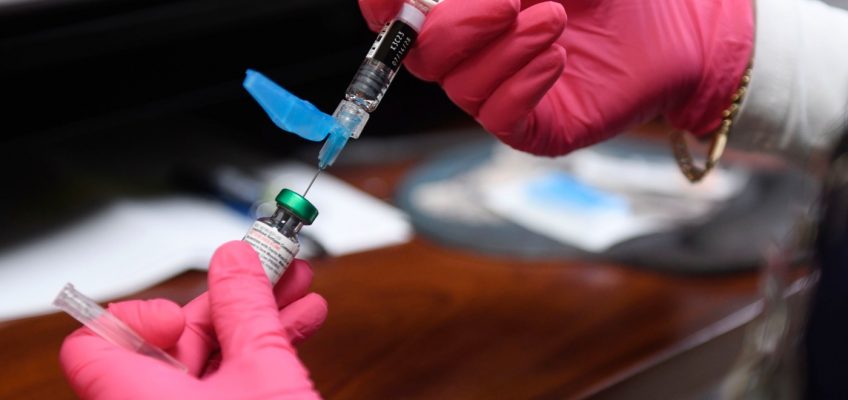North Dakota has reported its first case of measles in more than a month, just as the state hit a milestone that declared the outbreak in the state over.
The state Department of Health and Human Services confirmed to The Forum that the case was reported Thursday, July 10. An unvaccinated person from Williams County who recently traveled out of state contracted the virus, said HHS spokeswoman Mindy Michaels.
The case comes a day after North Dakota hit 42 days without any reports of measles. The U.S. Centers for Disease Control and Prevention considers an outbreak to have ended if 42 days have passed without a new report of measles.
The Peace Garden State’s last report of measles was May 28. Thursday’s case brings North Dakota to 35 cases reported this year.
The clock won’t reset because of the new case, said HHS Adult Immunization Manager Jenny Galbraith.
“This case is unrelated to the previous measles cases identified earlier this year in Williams County and is believed to have been acquired out of state,” she said. “At this time, there is only one confirmed case, and there is no evidence of community spread. As a result, a new outbreak has not been declared in Williams County related to this case.”
Williams County is on North Dakota’s western border. Its county seat is Williston.
HHS said it will continue to monitor measles activity.
Measles is a highly contagious virus that can be deadly, especially in children younger than 5 years old, according to the CDC. Nine in 10 people who are not vaccinated become infected, the CDC said.
There is no treatment for measles.
The U.S. declared measles eliminated in 2000 after the country developed a “highly effective vaccination program,” the CDC said. Outbreaks in multiple states have produced 1,288 cases as of Wednesday, the most reported in the U.S. in more than three decades.
More than two-thirds of the cases were found in people under the age of 20, the CDC said.
Three people have died from measles, and 162, or 13% of total cases, resulted in hospitalizations, the CDC said.
Vaccination rates across the country have declined in recent years, from 95% in 2019 to below 93% in 2023, according to the CDC.
The CDC recommends a vaccination rate of at least 95% to prevent the virus from spreading, according to HHS. North Dakota’s rate is less than 90%, though some counties dipped below 80%, according to HHS data.
North Dakota reported its first case of measles since 2011 on April 29. An unvaccinated child from Williams County likely contracted the virus while traveling out of state, according to HHS.
Reports of cases came in slowly through May, often one at a time. The most cases reported in one day was four on May 6, according to an HHS dashboard.
Of the state’s cases, 26 came in residents ages 5 to 19 years old, HHS said. Only two were hospitalized, according to the dashboard.
Four counties had measles cases. Williams County had the most with 16 reports.
Grand Forks County reported 10 cases, Cass County had seven and Burke County recorded one, according to the state dashboard.
North Dakota’s measles numbers are the worst since 1978, when the state reported 211 cases, HHS Immunization Director Molly Howell said in a late May statement. By the end of May, the state had 3.7 cases per 100,000 residents, the highest rate in the country.
As of Thursday, North Dakota tied for fourth-most measles cases in the U.S., according to a dashboard from the Center for Outbreak Response Innovation at Johns Hopkins University in Baltimore. Texas has the most with 792, followed by New Mexico with 95, Kansas with 87 and Ohio with 35, the data said.
Minnesota reported five this year, according to the dashboard.
Strict quarantine routine
Essentia Health in Fargo has been on high alert since the outbreak began in North Dakota, said Kelsey Nefzger, a registered nurse and immunization manager for the health care provider’s west market. Despite the contagious nature of measles, the state has not seen a lot of cases, which is great news, she said.
That’s likely because the state has a strict routine for quarantine, Nefzger said. Those who get the disease are advised to quarantine for 21 days.
“Making sure that we’re following those guidelines and educating patients once they are diagnosed with measles is really truly the thing that helps it from spreading,” Nefzger said. “I would say that the patients who have been identified as being exposed or being positive for measles have done an excellent job of helping to protect themselves and also protect our communities.”
She noted some counties have low vaccination rates because the state hasn’t seen measles in more than a decade.
“A lot of parents kind of have believed that, because we haven’t seen large amounts of measles, that it isn’t a dangerous disease, or that our grandparents survived it and it was all OK,” Nefzger said.
Related Articles
In a nation growing hostile toward drugs and homelessness, Los Angeles tries leniency
Rice Street clinic celebrates 100 years
Workplace mental health at risk as key federal agency faces cuts
Making healthy snacks a habit when afternoon energy slumps strike at work
Strike to end Saturday for health care workers at Stillwater clinic; issues not resolved
Getting vaccinated is “incredibly important” to prevent the spread of measles, she said. The CDC recommends two doses of the measles, mumps and rubella vaccine for those born after 1957 — one for children ages 12 to 15 months and the second between 4 and 6 years old.
Two doses of the MMR vaccine is 97% effective, while one dose is 93%.
“I think since the outbreaks in North Dakota, we have definitely seen parents bringing their children in to get vaccinated,” Nefzger said.


Leave a Reply